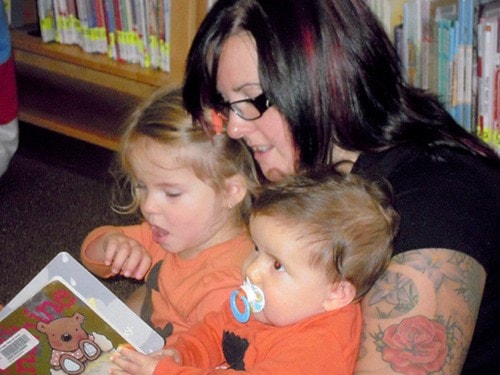Have you ever had one of those “Really, this is just annoying” songs get stuck in your head?
I spend a great deal of time either researching, rehearsing, or singing children’s songs so it happens to me a lot. This morning, it’s this one:
Have you seen the ghost of John?
All white bones with his skin all gone.
Oooh, ooooh, ooooh, oooh!
Wouldn’t it be chilly with no skin on?
Which (or witch?) is appropriate, I suppose, with it being Halloween and all.
But fun aside, we use songs in our Mother Goose and library story times because not only are they a lot of fun but there is a also strong link between music and early literacy.
With this in mind, I was toddling around the Edmonton Public Library (www.epl.ca) website recently, I came across a very good introduction to the six core early literacy skills:
• We like books! (or, print motivation): That’s what story time at your library is all about! We play, laugh, dance, sing, and generally make a lot of noise. And it’s certainly all for a good cause!
• We know words! (vocabulary): Knowing the names of things helps youngsters interact with their worlds. So when reading about a duck that gets stuck in a pumpkin (Pumpkin Trouble by Jan Thomas) children see the pumpkin, know what a pumpkin is, and then can make the connection between real things and print.
• We can tell a story! (narrative skills): Hearing stories allows youngsters to learn how to tell stories and describe events. Read or tell your children stories. There are tons of great children’s picture books – a current favourite is Ed Emberley’s Go Away Big Green Monster where the big green monster progressively appears and then disappears.
• We know letters! (letter knowledge): Everyone knows the alphabet song. At Mother Goose, we sing it every week. When children make the connection between letters and print - Eureka!
• We see words! (print awareness): When a child learns how to hold a book (or e-reader or tablet) and how to follow words on the page (or screen), they are on the road to literacy. When they come to understanding print has meaning … well, this is what reading is all about.
• We hear words! (or, phonological awareness): As Mem Fox writes in Reading Magic, children can’t learn to talk unless adults talk to them. Skill in this area allows children to hear and play with the smaller sounds within words. As adults, talk, talk, talk to the children in your lives. Talk all the time.
There are lots of good children’s music collections and the library has over 1,200 children’s music CD’s available for borrowing. And online there are lyrics for all occasions. Don’t worry if you “can’t” sing – I can’t either and the children at story time don’t seem to mind at all! Sometimes I’ll pop a puppet onto my hand, then it’s just the puppet making that awful racket!
And “Sing for your Health!” is the theme of this year’s Fall Health Fair, which is coming up on Saturday (Nov. 3). Visit Jacque and I at the library table – we’ll be telling stories, sharing books and, perhaps, even singing!
Until then, Happy Halloween!
On the nightstand:
British Columbia Bizarre: Stories, Whimsies, Facts and a Few Outright Lies from Canada’s Wacky West Coast by Rosemary Neering. Neering has published many B.C. history books and this one is a real treat. Short vignettes about little known (at least to me!) historical tidbits, such as the 1911 article in the Chilliwack Free Press about that city’s “first class roller rink.”
Also, George Bowering’s Pinboy: A Memoir. This is Bowering’s coming of age (he grew up in Oliver) story. Interesting, but I’m still undecided.
